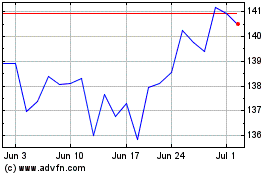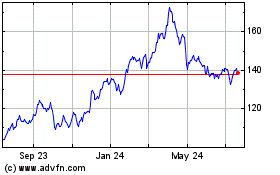By Rebecca Elliott and Bradley Olson
This article is being republished as part of our daily
reproduction of WSJ.com articles that also appeared in the U.S.
print edition of The Wall Street Journal (November 6, 2018).
From Exxon Mobil Corp. to Phillips 66, energy companies are
reaping banner profits by taking cheap oil landlocked in North
America and turning it into fuel.
Tremendous growth in oil output has overwhelmed pipelines and
depressed crude prices in some regions of Texas and Canada. That
has created a bonanza for companies in a position to take advantage
by converting it into gasoline and diesel.
Nowhere has the opportunity been bigger than near Canada, where
crude is trading for $43 a barrel below U.S. benchmark prices due
to bottlenecks. That is painful for producers there, but highly
lucrative for companies with nearby refineries in Canada or the
upper Midwest, from Exxon to smaller fuel makers like HollyFrontier
Corp.
"U.S. refining has really gone from being a dog to being a
fairly attractive business model," John Auers, an executive vice
president at consultancy Turner, Mason & Co., said. "I don't
think that's going to change any time soon."
Phillips 66, which says it is the largest industry buyer of
heavy Canadian crude, operated its nearby refineries at 108% of
capacity during the third quarter, earning an average $23.61 a
barrel processed there. That helped lift quarterly profits to
nearly $1.5 billion, an 81% increase from the same period last
year.
Exxon Chief Executive Darren Woods cited the company's access to
cheap crude from Canada and West Texas for its refineries as one of
the advantages that helped spur it to $6.2 billion in third-quarter
profits, its highest total in four years. The company said it can
process as much as 500,000 barrels a day of Canadian crude from
seven refineries.
"We are seeing the benefits of integration as we capture value
from advantaged feedstock from the Permian and Western Canada for
our North American refineries," Mr. Woods said.
Much as John D. Rockefeller amassed his fortune by refining
crude extracted in the first American oil boom, refiners are once
again finding an advantage as the U.S. has become one of the
world's largest crude producers.
North American oil production has soared as oil prices have
risen over the past two years, increasing 24% to more than 15
million barrels a day in July, according to the U.S. Energy
Information Administration.
The rapid growth has overwhelmed existing pipelines and made it
difficult for producers to move all their oil to market in areas
such as western Canada and the Permian Basin of West Texas and New
Mexico. The landlocked oil subsequently trades for far less in
those areas than oil shipped via pipelines to major selling hubs
such as Cushing, Okla.
Fuel makers with access to the inexpensive crude have reaped the
rewards.
BP PLC's underlying quarterly profit soared to $3.8 billion, the
highest level in five years, powered in part by the company's
massive refinery in Whiting, Ind. The plant, first opened by
Rockefeller's Standard Oil in 1889, is capable of running about
320,000 barrels a day of heavy crude from Canada.
Heavy Canadian crude traded for an average $28 a barrel below
U.S. benchmark prices during the third quarter, according to
S&P Global Platts, while oil sold in the Permian was discounted
by an average $14 a barrel. Oil in both regions is expected to
remain relatively cheap for at least another year, when new
pipelines are set to begin operating.
Permian, heavy Canadian and other similar crudes accounted for
about 57% of the oil HollyFrontier processed during the third
quarter, the company told investors Wednesday. The Dallas-based
refiner posted profits of more than $340 million, its highest
third-quarter income since 2012.
Refining companies that missed out on the Canadian trade showed
it in their results. Marathon Petroleum Corp. saw quarterly profits
decline 18% from the same period last year to $737 million, in part
because some of its Midwest refineries were offline for
maintenance. The company told investors it is now poised to process
about 500,000 barrels of Canadian crude daily. It also expects to
benefit in coming quarters from growing discounts on oil from North
Dakota's Bakken Shale.
"We kind of see this as a perfect storm," said Rick Hessling, a
senior vice president.
Oil in Clearbrook, Minn., one of the trading hubs for Bakken
crude, was selling for nearly $13 below U.S. benchmark prices this
week, according to S&P Global Platts.
Domestic demand for diesel and other fuel oils remains high, but
data from the Energy Information Administration show gasoline
demand has fallen off from a year ago as oil prices have risen and
refiners have operated at full tilt, boosting stockpiles.
"The real surprise, especially on the gasoline side, is just the
very high refinery utilization," said Gary Simmons, a senior vice
president for Valero Energy Corp. "You've had about a 2-to-1
increase in production over demand, and it's caused a surplus in
the inventory."
The export market has been a key release valve. U.S. exports of
refined products topped 5.3 million barrels daily in October, a 33%
increase from two years prior, according to the EIA. Top buyers
include Mexico, Canada and Japan.
"If you can get your hands on discounted crude oil, you're
incentivized to run it and then hope you can find a home for it,"
said Amy Kalt, a consultant for Baker & O'Brien Inc., an energy
consultancy.
Write to Rebecca Elliott at rebecca.elliott@wsj.com and Bradley
Olson at Bradley.Olson@wsj.com
(END) Dow Jones Newswires
November 06, 2018 02:47 ET (07:47 GMT)
Copyright (c) 2018 Dow Jones & Company, Inc.
Phillips 66 (NYSE:PSX)
Historical Stock Chart
From Oct 2024 to Nov 2024

Phillips 66 (NYSE:PSX)
Historical Stock Chart
From Nov 2023 to Nov 2024
